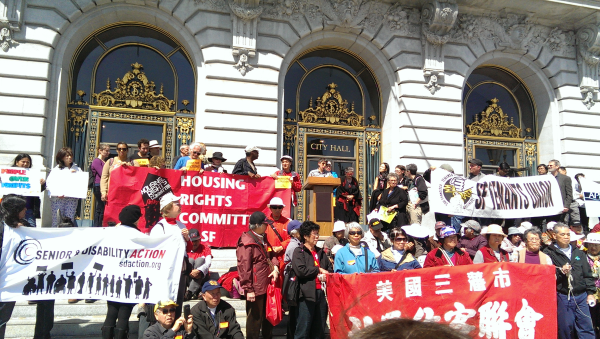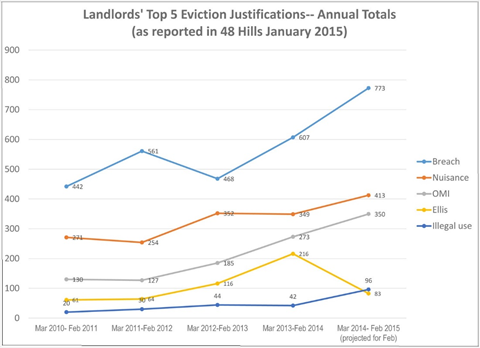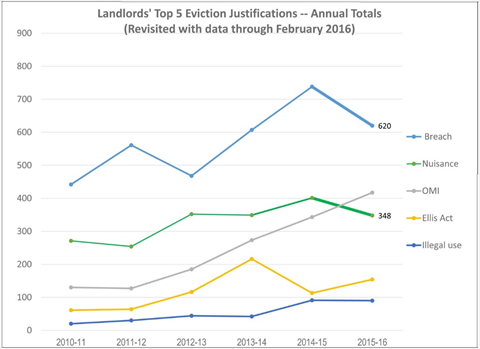Last year we reported on the surge of evictions devastating this city. As 2015 began, San Francisco’s Rent Board reported that increasing numbers of tenants were facing evictions. Over the previous four years, eviction notices had increased an average of 13% a year with no sign of abating. The previous fall, Realtor dollars had defeated a central tenant initiative, Proposition G, the anti-speculation tax. Tenant advocates were regrouping and looking for new solutions to what appeared to be an intractable problem.
Since then, the tenant-rights movement has made significant if unrecognized progress, winning a new package of tenant protections and turning around a number of key eviction cases. Together, these successes may be starting to change the overall eviction trends in San Francisco.

According to new data from the Rent Board, the number of permanent eviction notices filed in the 12-month period ending in February 2016 rose by only 0.7%– the lowest increase in five years.*
Evictions levels are still too high, but if tenant advocates continue to hold the line, San Francisco’s eviction surge may have peaked.
A closer look at how the types of evictions have changed reveals why total eviction rates flattened in the past 12 months. The following chart reflects the data we previously reported by category of eviction justifications alleged by landlords and reported to the Rent Board:
As reflected in last year’s chart, the top two categories of evictions were “breach of lease” and “nuisance.” These were eviction notices in which the tenants were accused of some kind of misconduct that the landlord claimed justified evictions. Reports from housing counselors revealed that increasing numbers of these tenant ‘fault’ cases were based upon minor infractions or even trumped up charges. “Unauthorized guests or roommates” was a growing favorite landlord “breach of lease” allegation. These two leading causes of eviction were driving a majority of the increased evictions across the city.
After the publication of our 48 Hills article, the rise in what were called “low-fault” evictions led the SF Anti-Displacement Coalition (SFADC) to develop a set of recommended reforms to strengthen protections for tenants.
In May 2015, Supervisor Jane Kim took on the challenge of turning the SFADC’s recommendations into law by introducing what we called “Eviction Protections 2.0.” After a tough fight at the Board of Supervisors, the reforms were approved. Almost immediately the rate of new “low-fault” eviction filings declined as reflected in the data for the entire 12-month period ending in this February:
The decline in breach and nuisance evictions combined to reduce the total number of evictions for the year.
“We are very encouraged how 2.0 has impacted gotcha evictions,” says Fred Sherburn-Zimmer, director of the Housing Rights Committee of San Francisco. “We are seeing fewer of these notices, and we now have new tools to help tenants fight back who a year ago would have been put out on the street.”
The apparent success of Eviction Protections 2.0 has led advocates to consider similarly targeted reforms to address other elements of what is the broader threat of displacement and gentrification, particularly Owner-Move-In and Ellis Act evictions. “We are researching new legislative reforms that will challenge the growing number of sham owner move-in evictions,” says Deepa Varma, director of the San Francisco Tenants Union.
Others see additional lessons from the ongoing fight against Ellis Act evictions. While Ellis Act evictions rose in 2015, their levels remain lower than their peak in 2013. As we have previously reported, new Ellis Act eviction notices fell as voters considered 2014’s Proposition G, the real estate speculation tax. After Proposition G’s defeat, landlords resumed issuing Ellis Act notices but at lower levels. Advocates believe effective organizing and tenant representation has kept a lid on Ellis evictions.
Attorney Steve Collier at the Tenderloin Housing Clinic has represented many tenants in cases that blocked or delayed Ellis evictions. “By putting up a fight against individual Ellis and OMI evictions we are saving homes and discouraging other speculators,” says Collier. “Improving the law is very important but we also need to do more to provide full representation to tenants facing eviction using the laws we have already won.”
Tenant advocates appear ready to take on both challenges. New legislation to protect families and teachers against eviction has been introduced by Supervisor Campos. And later this month, the SFADC is launching a new network to train and support tenant counselors and organizers to fight individual eviction cases. Advocates see 2016 as a pivotal year in determining whether last year’s stabilizing of the city’s eviction levels was a mere pause or the beginning of the end of San Francisco eviction nightmare.
*Based upon the Rent Board’s 2015-16 Annual Report on Eviction Notices. As noted in the Rent Board’s report, there was an unusual set of notices for temporary displacements for repairs from one development that lifted total notices for 2015-16. The data cited here references only notices for permanent evictions.






